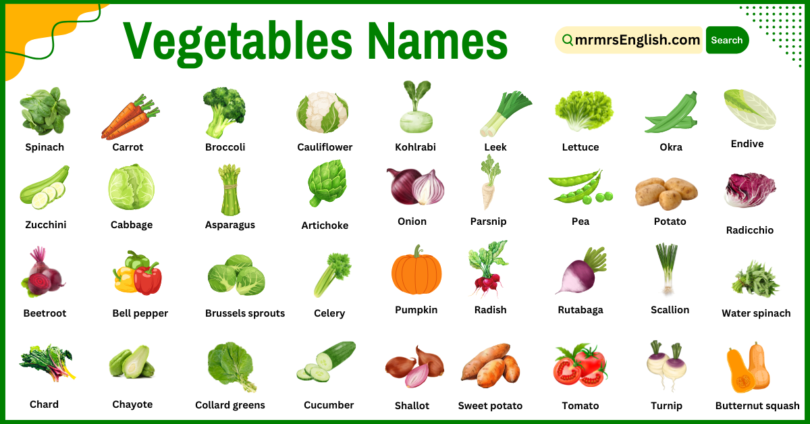Learning the vegetables names in English is an important thing for all English Learners and Students. Vegetables are a key part of our meals and are very good for our health. They come in many types, colors, and flavors. Some Common Vegetables Names are, Carrot, Broccoli, Cauliflower, Zucchini, Cabbage, Asparagus, Artichoke, Beetroot, and Bell pepper. In this article, I have covered 80 Vegetables Names in English and their Pictures. Each vegetable brings its own taste and benefits, making our meals not just tasty but also healthy. All are given, let’s learn…
80 Vegetables Names in English
- Spinach
- Carrot
- Broccoli
- Cauliflower
- Zucchini
- Cabbage
- Asparagus
- Artichoke
- Beetroot
- Bell pepper
- Brussels sprouts
- Celery
- Chard
- Chayote
- Collard greens
- Cucumber
- Eggplant
- Fennel
- Green bean
- Kale
80 Vegetables Names and their Pictures
- Spinach:
Dark green leaves packed with vitamins, commonly used in salads, smoothies, or as a cooked side for its earthy flavor and nutrition.

- Carrot:
Bright orange root vegetable, enjoyed raw in salads or cooked in soups and stews; known for its crunch and sweetness.

- Broccoli:
Green, tree-like florets that add texture and fiber to meals; often steamed or stir-fried for a mild, fresh taste.

- Cauliflower:
Pale, creamy vegetable that’s great roasted, mashed, or used as a low-carb rice alternative; has a subtle, nutty flavor.

- Zucchini:
Soft green vegetable, often sautéed, grilled, or spiralized into noodles for its mild taste and versatility.

- Cabbage:
Known for its crunch and vitamin content, this leafy vegetable can be either light or dark green and is eaten raw in salads or cooked in soups and stir-fries.

- Asparagus:
Slim green stalks with a unique flavor, often grilled or steamed; popular in side dishes and full of nutrients.

- Artichoke:
Green, layered flower bud with tender leaves, often steamed or used in dips; valued for its antioxidants and fiber.

- Beetroot:
Deep red-purple root with a sweet, earthy flavor, often roasted, juiced, or added to salads for a boost of iron.

- Bell Pepper:
Vibrant in colors like red, yellow, and green, this crisp vegetable is used raw in salads or cooked in stir-fries for its sweet, juicy taste.

- Brussels Sprouts:
Small green buds with a cabbage-like flavor, typically roasted or steamed for a rich, slightly nutty taste.

- Celery:
Pale green, crunchy stalks often enjoyed raw as a snack or added to soups and stews for a fresh, mild flavor.

- Chard:
Dark green leaves with bright red or yellow stems, commonly used in sautés and salads for a slightly bitter taste.

- Chayote:
Light green squash with a mild, crisp flavor, often eaten raw or in stews for its refreshing taste and fiber.

- Collard Greens:
Large dark green leaves with a robust flavor, often boiled or sautéed for side dishes rich in calcium.

- Cucumber:
It is common to combine dark green leaves with bright red or yellow stems to add a touch of bitterness to sautés and salads.

- Eggplant:
Deep purple skin with soft, spongy flesh inside, often roasted or grilled for its rich, savory taste in dishes.

- Fennel:
Pale green bulb with feathery leaves, offering a slight anise flavor; often used raw in salads or cooked in soups for freshness.

- Green Bean:
Slim green pods with a mild taste, typically steamed or sautéed and enjoyed for their crunchy texture.

- Kale:
Dark green leafy vegetable with a tough texture, commonly used in salads, smoothies, or baked as chips for its rich nutrients.

Vegetables Names in English
- Kohlrabi
- Leek
- Lettuce
- Okra
- Onion
- Parsnip
- Pea
- Potato
- Pumpkin
- Radish
- Rutabaga
- Scallion
- Shallot
- Sweet potato
- Tomato
- Turnip
- Watercress
- Yam
- Arugula
- Bok choy
50 vegetables name and Pictures
- Kohlrabi:
Crisp vegetable with a light green or purple skin and white inside; enjoyed raw or cooked, adding a sweet, mild flavor to salads or stir-fries.

- Leek:
Long, green stalks with white bases; used for its mild onion flavor in soups, stews, or as a seasoning.

- Lettuce:
Light or dark green leafy vegetable with a crisp texture; commonly used in salads and sandwiches for freshness and hydration.

- Okra:
Green, slender pods with tiny seeds inside, often added to soups, stews, or fried for its unique texture.

- Onion:
Layered vegetable with white, yellow, or red skin; brings a sharp, pungent flavor to countless dishes when raw, sautéed, or caramelized.

- Parsnip:
Pale beige root vegetable similar in shape to carrots, used in soups, stews, or roasted for its sweet, nutty flavor.

- Pea:
Small, round green seeds, enjoyed fresh, steamed, or in soups; known for their mild sweetness and high fiber.

- Potato:
Brown, red, or yellow skin with white or yellow flesh; a staple ingredient that can be baked, mashed, or fried for its versatility and mild taste.

- Pumpkin:
Large orange squash with soft flesh, often roasted, pureed, or used in soups and pies for its naturally sweet flavor.

- Radish:
Small round or oblong root with red or white skin and a peppery taste; often sliced in salads for a crisp bite.

- Rutabaga:
A sweet, earthy root vegetable with purple and beige skins, it’s frequently roasted or mashed for filling meals.

- Scallion:
Slim green stalks with white bottoms, used raw in salads or as a garnish for its mild onion flavor.

- Shallot:
Small, brownish or reddish bulbs with a mild, sweet onion flavor, ideal for salads, dressings, and sauces.

- Sweet Potato:
Orange or purple-skinned root with orange flesh, commonly baked, mashed, or roasted for its natural sweetness and high nutrients.

- Tomato:
Red, yellow, or orange juicy fruit often used in salads, sauces, and sandwiches, adding a bright, tangy flavor.

- Turnip:
White and purple-skinned root with a peppery taste, typically boiled, mashed, or roasted in savory dishes.

- Watercress:
Small, green leafy vegetable with a peppery flavor, commonly added to salads or sandwiches for a fresh, zesty touch.

- Yam:
Brown-skinned with orange or purple flesh, similar to sweet potatoes but starchier; often baked or roasted for a rich taste.

- Arugula:
Dark green leaves with a peppery flavor, used in salads and as a garnish for a bold taste and crunch.

- Bok Choy:
Green leafy vegetable with thick white stalks, often used in stir-fries or soups for a mild, slightly sweet taste and crunch.

50+Vegetables names list in English
- Endive
- Jicama
- Mustard greens
- Napa cabbage
- Radicchio
- Rocket
- Sorrel
- Tatsoi
- Water spinach
- Yellow squash
- Bamboo shoots
- Bitter melon
- Butternut squash
- Celeriac
- Chinese broccoli
- Daikon
- Garlic
- Ginger
- Jerusalem artichoke
- Mung bean sprouts
Vegetables name and their Pictures
- Endive:
Crisp green and white leafy vegetable with a slightly bitter taste; great in salads or as a crunchy snack.

- Jicama:
Brown-skinned root with a white, juicy interior; adds crunch and a mild sweetness to salads or can be eaten raw.

- Mustard Greens:
Dark green leaves with a peppery bite, often used in salads or cooked for their spicy flavor and health benefits.

- Napa Cabbage:
Light green, tender leaves with a mild taste, commonly used in salads, stir-fries, or kimchi for its crunch.

- Radicchio:
Red and white leafy vegetable with a slightly bitter flavor, often used in salads to add color and depth.

- Rocket:
Small dark green leaves with a peppery taste, used in salads or as a garnish for a fresh, sharp flavor.

- Sorrel:
Bright green leaves with a tangy, lemon-like flavor, perfect for adding a sour kick to salads or soups.

- Tatsoi:
Small, spoon-shaped dark green leaves with a mild mustard flavor, often used in salads or stir-fries.

- Water Spinach: Long green leaves with hollow stems, popular in stir-fries or soups for its mild flavor and tender texture.

- Yellow Squash:
Bright yellow, tender-skinned vegetable with a mild flavor, used in sautés, grilling, or casseroles.

- Bamboo Shoots:
Light-colored, crisp shoots from young bamboo; often sliced into stir-fries or soups for texture.

- Bitter Melon:
Bumpy green vegetable with a bitter taste, commonly cooked in Asian dishes for its distinct flavor and health benefits.

- Butternut Squash:
Creamy orange flesh with a sweet, nutty flavor, often roasted or pureed in soups for a rich taste.

- Celeriac:
Rough, beige-skinned root with a mild celery flavor; used in soups, purees, or as a mash alternative.

- Chinese Broccoli:
Dark green leaves with thick stems, often steamed or stir-fried for a slightly bitter, earthy flavor.

- Daikon:
Long white radish with a mild, crisp taste, often shredded into salads or pickled in Asian cuisine.

- Garlic:
Small, white bulb with a strong, pungent flavor, widely used as a seasoning in various dishes for its bold taste.

- Ginger:
Light brown root with a spicy, warming flavor; grated or sliced in teas, marinades, or stir-fries.

- Jerusalem Artichoke:
Brown-skinned tuber with white flesh and a nutty, slightly sweet taste; often roasted or pureed.

- Mung Bean Sprouts:
Small white and yellow sprouts with a mild, fresh flavor, commonly added to salads and stir-fries.

100 Vegetables name in English
- Purslane
- Ramps
- Snap pea
- Snow pea
- Spring onion
- Taro
- Turmeric
- Wasabi
- Winter melon
- Acorn squash
- Banana pepper
- Black-eyed pea
- Broad bean
- Butter lettuce
- Cassava
- Chicory
- Horseradish
- Lamb’s lettuce
- Swiss chard
- Fiddlehead fern
All Vegetables Pictures with their names
- Purslane:
Small, thick green leaves with a slightly tangy taste, often added to salads or used as a garnish for a crisp texture.

- Ramps:
Green, broad leaves with a white bulb, known for their mild onion and garlic flavor; used in soups, sautés, or as a seasoning.

- Snap Pea:
Plump green pods that can be eaten whole, adding a sweet crunch to salads or stir-fries.

- Snow Pea:
Flat green pods with a mild taste, enjoyed raw or quickly stir-fried for a light, fresh flavor.

- Spring Onion:
Slim, green stalks with white bottoms; often used raw in salads or as a garnish for a mild, onion-like taste.

- Taro:
Brown-skinned root with purple-flecked white flesh; has a starchy, mild flavor, often boiled or used in soups and desserts.

- Turmeric:
Bright orange root with a warm, earthy taste, widely used as a spice in cooking and for its health benefits.

- Wasabi:
Green root with a sharp, spicy flavor, often grated fresh to add a fiery kick to sushi and other dishes.

- Winter Melon:
Large, green-skinned melon with pale flesh, commonly used in soups for its mild, cooling flavor.

- Acorn Squash:
Dark green or orange with a sweet, nutty taste; usually roasted or baked for a rich flavor in savory dishes.

- Banana Pepper:
Yellow, mild pepper often used fresh in salads or pickled to add a tangy, subtle spice.

- Black-Eyed Pea:
Cream-colored with a black spot, commonly cooked in soups and stews, known for its earthy, hearty taste.

- Broad Bean:
Light green beans often enjoyed fresh, steamed, or in stews for their creamy texture and slightly sweet flavor.

- Butter Lettuce:
Soft, light green leaves with a mild, buttery flavor, perfect for salads or wraps.

- Cassava:
Brown-skinned root with a firm, white interior; often boiled or fried, providing a starchy, mild flavor.

- Chicory:
Dark green or red leafy vegetable with a slightly bitter taste, often used in salads or as a coffee substitute when roasted.

- Horseradish:
White, firm root with a strong, spicy flavor; commonly grated as a condiment for its intense taste.

- Lamb’s Lettuce:
Small, round green leaves with a delicate, slightly nutty flavor, used in salads for a mild, fresh taste.

- Swiss Chard:
Green leaves with colorful stems in red or yellow, enjoyed sautéed or in salads for its earthy, slightly bitter flavor.

Learn Also:












Leave a Comment